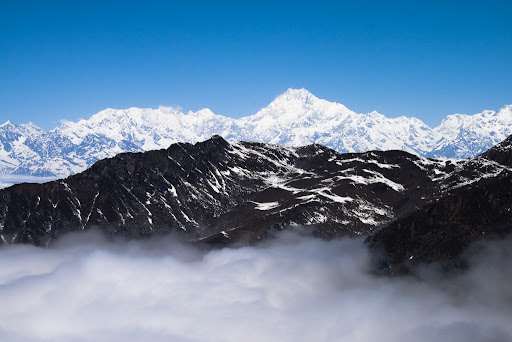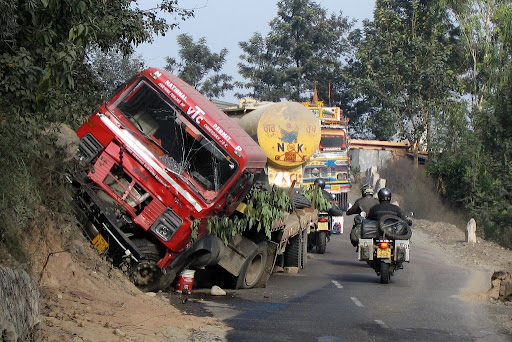
The first rule, for an overland-travelling continental European at least, and that we're reminded of when crossing from China to Pakistan - Pakistan being much like India as far as driving is concerned (
politically correct disclaimer) - is that in India one must drive on the left-hand side of the road. Well, it turns out this is mostly wishful thinking from the authorities (just like most Indian laws I should add). The truth is, it is very acceptable to drive on the right-hand side of the road, or right in the middle if the driver fancies it. Examples that come in mind is if the tarmac happens to be better on the other side, or if the speed bump is lower there. The only rule of practical value that you are suppose to follow is that,
as much as possible, and if you care about your life (which seems not to be a big concern for Indians),
one crosses each other on the left-hand side. Note that the hard shoulder is part of the road, so that trucks routinely overtake each other in front of an incoming vehicle as long as there is some escape route on the side of the road. And for a bike that means a 50 cm-wide rubble shoulder is plenty. Which leads us to the second (and most important) rule: priority between the vehicles.
In india the rule is very simple and goes by the aphorism:
might is right. That means that the bicycles give way for the rickshaws and the rickshaws to the trucks, etc.. this is a simple law of self-preservation (of your vehicle more than the passengers): an Indian driver will give way only if there is a chance of his vehicle being badly hurt. Of course, at this game of chicken I would always lose, only able to scare some bicycles at times. But at the very top of the hierarchy, the one who can use the road almost blindly, is not the heavy 18-wheelers or the military convoy heading for the Kashmere border: the king of the road is the almighty holy
cow, who in its phlegmatic stroll dismisses all motorized traffic as pure inconvenience, and undeterred by the furious horn blowing, knows perfectly well that no Indian in its right mind would hurt it, no matter what. Incidentally this is one major difference between Pakistan and India: the muslims like the cows better in their plates than on the road, so they keep a very low profile over there and steer clear of the traffic.
An interesting category is the tractor drivers. They usually have little common sense and lack the most basic instruction on driving on the road. Coming out of a field or dirt track onto a road, a tractor driver will never pay attention to the incoming traffic and cut right in front of you without even a glance in your direction.
Another major road hazard is made of the various oxen- or camel carts. The point is, the "drivers" don't always have full control over their animals and they can have unpredictable behaviors. Better to steer clear of them when possible.
Walking
India is a very big country, but it is populated by more than 1 billion people, and it seems a fair size of these live near or on the street. Apart from some desert areas in Rajasthan or Ladakh, it's hard to drive more than 5 minutes without crossing some village, and invariably the bazaar borders the main road and most of the population either works, shops or just hangs out there for lack of anything better to do. Including children of course. And those pedestrians seem to be so used to the roaring of the trucks, buses or jeeps crossing them that they barely pay attention to anything not deafening loud (and I reckon most of the Indians must be deaf for living there, proof of it if needs be the way Indian shout to each other instead of talking). Which means that they cross the road without watching and often right in front of you unless you constantly jam your horn. Failing to do this makes for some very near misses and heavy cursing from each side. Crossing a town without horning is considered very dangerous and inexcusable.
A working (and if possible painfully loud) horn is the single required piece of equipment for your vehicle to be considered road-safe. The brakes come a distant second. I've witnessed (and cursed) a mechanic in a bike shop spending hours tuning a horn that was not quite loud enough for the owner's liking - even though the tires needed much more immediate attention.
Walking around is therefore pretty annoying, as you're in a constant threat by incoming vehicles. You think you'd be safe on the side walk, but the thing is, they are in such a bad sate of repair, and usually crowded by various shops and hawkers that most of the time you end up walking on the road proper, which is usually in a much better condition. Which means that you have to live with the horns blowing right into your ears, for no apparent reason. At first I would stop and turn around to see what's wrong. Then I found out that the horning is not to complain about something but just to warn people that a vehicle is coming, as Indians never look and walk with their ears. So after a while I got the hang of it and tried to ignore the horns and keep walking (they will pass you a few centimeters away but won't actually run you down - well, I think). Actually, I'll never get used to these auditive aggression, and just thinking about the people living in the street in that noise (and pollution!) makes me sick. When I ride in a city I would wear my in-ear headphones to muffle the noise and save my nerves - even at the expense of ignoring the occasional legitimate horn blow.
Orientation
It's not easy to find a road map in India, but it is impossible to find a good one. I've used 3 different ones and all show gross mistakes and omissions. Some roads shown on the map are just inexistent or in construction. Some very good roads are totally missing from the maps. Different map have different errors, but in all cases they're only useful for rough planning and estimates of distances. As it happens, the world map on my GPS wasn't much worse as only the bigger highways can be trusted on the printed map anyway. And I used it at least as often as in Mongolia to find my way around!
It's much easier to ask for directions when people speak English, but in some places virtually nobody speaks English. A beginner's mistake is to ask "is this the direction to .." as the answer is usually "yes" (or just a head wobble) even though they didn't understand the question or have no idea about the answer. It's much better to ask "what is the direction to .." but then you have to ask several different persons to have a reliable answer (
Ask the audience).
Another basic mistake is to take out a map. Most people have never seen a map and they will just be curious and start to read out location names without making any attempt at helping you out. In addition some locations have different names depending on the language (local or Hindi or English) or your pronunciation is far enough from theirs that they don't understand what you're talking about. As if it wasn't confusing enough, as soon as you start talking to somebody, a crowd will rapidly form around you and they will start to argue about the directions. In addition, for some reason, they want to know where you come from and what's the bike's price before they listen to your question.
Every so often, looking for some "National Highway" on my way out of a town, I'd hit a really rough piece of dirt road, which at first would make me turn around to ask for the correct road, looking around until I would eventually venture pass the bad stretch and find out it was actually the highway. It tuns out that the load of traffic and presence of buses and trucks gives a better hint to the importance of the road than it's width or state of repair. I've also taken minor roads (not even on the map), which although narrow wore excellent tarmac and little traffic and allowed me to make better progress than a major highway which might be badly pot-holed and jammed with thousands of reckless buses and slow-moving trucks.
Sometimes the larger highways would have 2 lanes in each direction, separated by a ditch or a barrier, western-style. That might give you a false sense of security, thinking that the incoming vehicles couldn't overtake on your lane (see below). That may be true, but that doesn't matter because if a vehicle is getting on the road and wants to go right, the driver will do so anyway until he reaches the next crossing, driving on the right-hand side of the road (another perfectly legitimate exception to the first rule). You just have to be ready for that. One day I was driving on a very fine highway south of Rajasthan with light traffic, relaxing a little, when coming out of a curve I saw in front of me 2 trucks overtaking each other and coming toward me. It took me a couple seconds to take in account the fact that they were driving on the wrong side of the road (and not me). I just had time to scramble out of the road, and keep moving slowly among the increasingly chaotic traffic. Only later on did I see the overturned truck that blocked both opposite lanes. As it happened at a place where it was possible to cross over to the other side, the vehicles just kept moving on the right-hand side without so much as slowing down or even restraining to overtake.
Slow Vehicles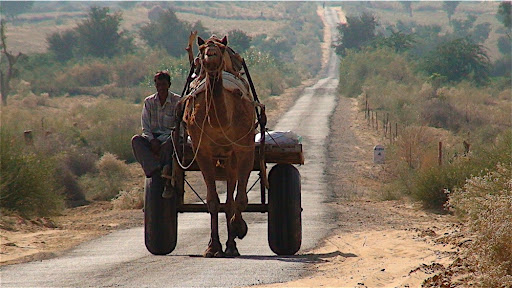
Which leads to the last rule:
if you can't see any immediate danger from where you are, then you can overtake. That means not only in blind corners but also if the incoming vehicle is lighter (see priority rule above). And if there isn't enough space for overtaking, you carry on and just blink your lights to signify: "Hey buddy, if you care for your life then get out my way because I'm not backing off", maybe blow your horn to ask the vehicle you're overtaking to slow down. If both vehicles are of equal weight (such as two trucks) then it's a game of chicken, usually ending with the 2 vehicles passing with just millimeters between them (often a little less, as attested by the badly scratched body of the buses). But even in India the laws of physics prevail and that explains some of the wrecks along the road. Now, an added convention is that the incoming vehicle is supposed to make room for you, by stepping on the hard shoulder. Only that sometimes there's a ditch and that's ends up with yet another tipped-over truck on he side of the road.
The first thing you notice in India is that virtually all trucks and buses wear the sign "Blow Horn" on the back. Quit puzzling at first, but then I found out that the truck wallahs don't look much into their mirrors (when they have one) so they expect you to warn them when you want to overtake Often they have no door so they will hear you, but see the rule about the loud horn. The well-behaved driver will then with a lazy sign of the hand show you to stay put or to go for it, although according to the basic overtaking rule they will motion you on right into a blind corner. Quite often though they will just ignore you, and keep driving in the middle of the road, if that's what they've been doing, for a reason best known to themselves. It's then up to you to wait until he changes his mind, or force your way through the narrow space. That still leaves a reasonable margin for a bike, but the jeep drivers would do it as well, much to the despair of their occasional Western passengers.
The most dangerous category in this sport is definitely the million of buses that roam the country. They're all driving like there's no tomorrow, I guess there's a bonus for keeping the schedule. The trucks in comparison are much more laid-back. They also drive quite a bit slower, 40-50 km/h, so the buses are pretty much forced to overtake at any cost to keep up.
Speed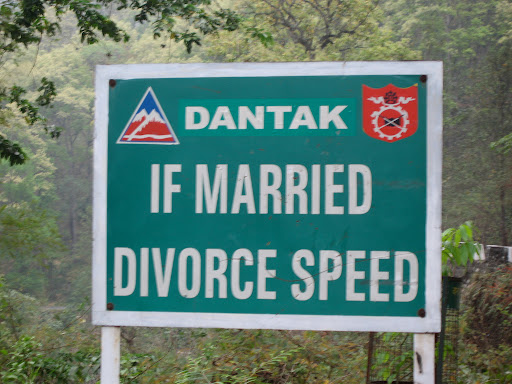
One thing that keeps India apart from central Asian is the complete lack of speed controls. As it happens, I don't even know what is the general speed limit on Indian roads. But that doesn't matter, because in general the bad state of repair of the tarmac or the load of traffic prevents you to speed. In general, te Indians are no speed freaks, ut nevertheless in the villages the speed in controlled by the frequent (and generally unmarked) speed bumps ("
speed breaks" or even "
speed brakes" in Hinglish). That definitely slows down the trucks and buses, but it just happens that on my bike some of these bumps are easier to pass around 40-50 km/h, so I would find myself
accelerating in view of such an obstacle. More often though I wouldn't pay attention and be suddenly jerked up by the bump, which is harmless on my bike but that could wreak havoc on a normal passenger car.
The debated question is: is it safer to ride really slow ? in my opinion it is not, as that mans you constantly have vehicles tailgating you. Tailgating here means about 50 cm behind your back, sometimes even less as I remember feeling a bumper leaning on my boots. This is quite unnerving and certainly not very safe. Note that if you try to keep away from the vehicle in front of you by keeping a safe 5-10 meters, this is immediately defeated by some car passing you and inserting itself right into that slot (which means, 50 cm before your front wheel). I found out that the only way to avoid that is by keeping an average speed a little higher than most vehicles, around 80 km/h, which allows me to keep out of reach of them - at the expense of having to often overtake, which is sometimes impossible, particularly in towns or on very twisty roads.
City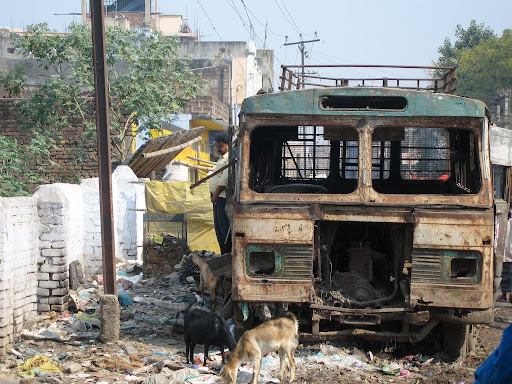
Driving in a city is definitely not a lot of fun, but often cannot be avoided as even the major highways would run right in the middle of it. Besides the chaotic circulation, finding his way through is not easy as there are generally no direction signs nor any kind of street name. Given the anarchist way of driving and the overload of vehicles, it's a miracle that you don't end up more often stuck in a gridlock. The thousands of auto-rickshaws and seven-seaters (called like this because they normally fit between 12-15 people) compete with the countless buses operating on routes that don't show on any map. The traffic lights are purely decorative unless guarded by the police.
There aren't that many cars in India, mainly because of the price. The cheaper cost more than 2 lakhs (about 4000$), more than most people can afford (Tata is currently designing the so-called "1 lakh" car). Much cheaper and therefore more popular is the small India-made motorbike, typically between 125-180 cc, that can easily accommodate 3-4 people, often more, and allow to drive at reckless speeds in towns - in particular in the narrow and crowded lanes of Kathmandu or Varanasi. In larger cities, almost half the bikers even wear a helmet, although in general none of their pillions. Helmets cost money of course, but the main reason is certainly that it is impossible to talk on the phone while driving a bike if you're wearing a helmet, so that means being handicapped for most Indians.
RailroadsThe railroads are crisscrossing the whole country, so it's not uncommon to be blocked at a crossing. They are always man-operated, and they seem to be pretty conservative as it is not unusual to wait 20 minutes for a train to come. Of course, pedestrians, bicycles and small bikes don't wait and duck under the gates, which means that the train come very slowly blasting their horns.
Meanwhile, the vehicles keep coming, and in the best Indian tradition they will pack as close as possible to the gates, occupying both lanes of the road on either side of the gates. Normally, after the gates open the situation would end up in a huge gridlock, and for a while it does when everybody runs at the same time as if their lives depended on getting through as quickly as possible. But amazingly, after an initial chaos and noises of metal-against-metal grinding, the traffic clears out in a few minutes, giving way to the more cautious trucks and the occasional Western biker.
Mechanic
Where Central Asia meets India is on the frequency of trucks break downs. Although the Kamaz drivers spend probably more time under their truck than in the cabin, at least they try to keep out of the road. The Tata wallahs don't seem to mind and they would stop dead in the middle of the road to change a tire, or an entire axle for that matter. And they do spend a lot of time changing tires as they only change them when they blow up. That explains the millions of tire repair shops at every corner of the country, who are capable of repairing the most worn out tires. It's hard then for me to repair myself the few punctures I experienced, when for 30 rps I can have it done by the nearby tire wallah and help him make a living, while sipping a chai at the next dhaba.
If the break-down is more serious and need help, typically when a truck as overturned, the wallahs will stay there and camp until they get some help, even for a few days. Never would hey leave their vehicles as their payload would disappear in a minute. But it takes a really big hit to stop a truck, as I have seen on the roads wrecks missing most of the cabin and the rear wheels going a different direction than the front ones, on a straight road.
If after that you think that driving in India is too dangerous and rather take the public transportation, then think twice. Except for the trains and planes, the buses and shared jeeps share the same roads and hazards. And after having ridden a local bus, up and down the mountains, I can attest that you need good nerves and a certain lack of sense of self-preservation to do it. Unless the God for which the driver has set up an altar on his dashboard is watching closely after you. I guess the fatalism and belief in reincarnation shared by the Indians goes a long way about explaining the danger of the roads - and the 100'000s of casualties every year.

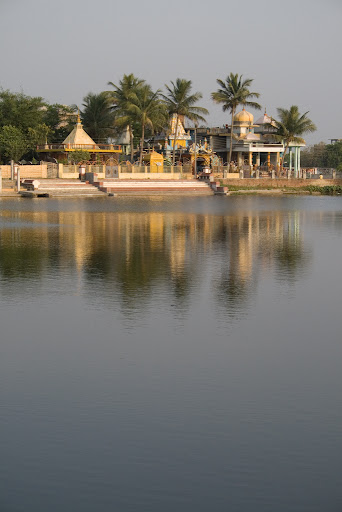 My first reaction to Nepal was somewhat like Obelix returning from Switzerland: it's flat. That's true, the Terai, is flat like a pancake although beautiful with many rivers where farmers bring their water buffaloes and green paddy fields. Of course the northern half is in the Himalaya and boasts the highest mountain in the world, but Pakistan has #2 and India #3, so they're not short on high mountains either. It's not until I reached Kathmandu that I had to cross a pass. The highest one was boasting "the best views in the whole Himalaya" but Spring is definitely not a good time in Nepal either: haze, fog and late afternoon storms are the norm.
My first reaction to Nepal was somewhat like Obelix returning from Switzerland: it's flat. That's true, the Terai, is flat like a pancake although beautiful with many rivers where farmers bring their water buffaloes and green paddy fields. Of course the northern half is in the Himalaya and boasts the highest mountain in the world, but Pakistan has #2 and India #3, so they're not short on high mountains either. It's not until I reached Kathmandu that I had to cross a pass. The highest one was boasting "the best views in the whole Himalaya" but Spring is definitely not a good time in Nepal either: haze, fog and late afternoon storms are the norm.








